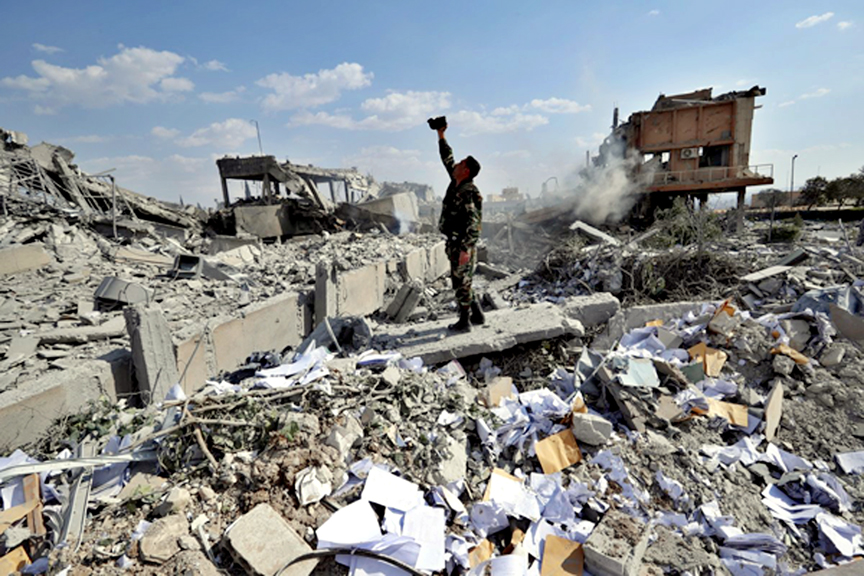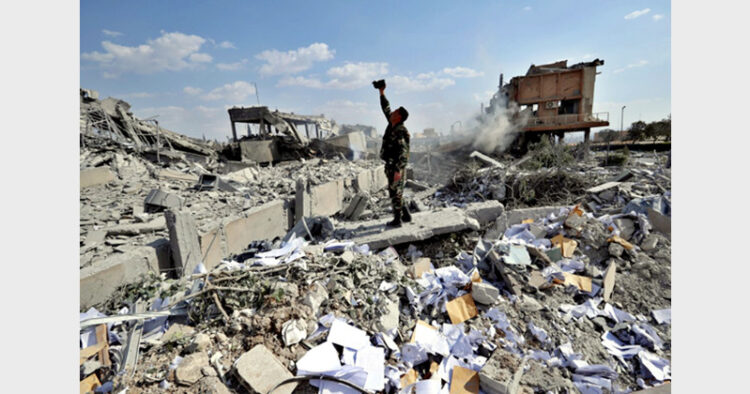Is the world heading towards the third World War ? The missile attacks of the US and its allies on Syria have triggered the debate amid grave apprehensions

An emergency meeting of the Security Council was called by Russia to condemn the allied action. US President Trump had called the chemical weapon attack “crimes of a monster”. Mission accomplished, he wrote on Twitter. Syria’s chief allies, Russia and Iran, called the use of force by the United States, Britain and France “a military crime” and “act of aggression” with the potential to worsen a humanitarian crisis after years of civil war. Defence Secretary of America James Mattis said the Friday strikes were a ‘One time shot”. But more could follow if there were more chemical weapon attacks. The United States had first struck Syria in April, 2017. This conflict which was generated from a civil war in Syria is heating up the Third World War. The Russian defence experts have cautioned the world to get ready for the Third World War. The US and the West laughed at this exposition. Nevertheless, the world is divided. Russia along with Iran has a support of China and some of the Middle East countries.
Chemical Experts in Syria
“Today the U.N. security team entered Douma … in order to assess the security situation on the ground and if this United Nations security team decided that the situation is sound in Douma then the fact-finding mission will begin its work in Douma tomorrow,” Syrian Ambassador Bashar Ja’afari told the U.N. Security Council on Tuesday.
A team of experts from the Organisation for the Prohibition of Chemical Weapons has also arrived in Syria, but it is not sure whether it could enter Douma, where the chemical attack is believed to have taken place. State Department spokeswoman Heather Nauert said she was aware of reports from Syria that inspectors from the OPCW had been able to see the town but “our understanding is that the team has not entered Douma.”
More than 25,000 Syrians have lost their lives in four and a half years of armed conflict, which began with anti-government protests before escalating into a full-scale civil war. More than 11 million others have been forced from their homes as forces loyal to President al-Assad and those opposed to his rule battle each other- as well as jihadist militants from so-called Islamic State. Pro-democracy protests erupted in March 2011 in the southern city of Deraa after the arrest and torture of some teenagers who painted revolutionary slogans on a school wall. After security forces opened fire on demonstrators, killing several, more took to the streets. The unrest triggered nationwide protests demanding President Assad’s resignation. More than 90,000 hundred people have been killed in the conflict. Now the conflict is more than just a battle between those for or against Assad. It has acquired sectarian overtones, pitching the country’s Sunni majority against the president’s Shia Alawite sect, and drawn in regional and world powers. The rise of the Jihadist group Islamic State has added a further dimension.
The conflict in Syria has drawn in major global powers, supporting and opposing president Bashar-al Assad and the myriad rebel groups raged against him. World powers meeting in Vienna agreed to a nine-point plan they hope would pave the way for a ceasefire in Syria-but they remain divided on what happens to President Assad. Russia is one of Syrian President Bashar al-Assad’s most important international backers and the survival of the regime is critical to maintaining Russian interests in the country. It has blocked resolutions critical of Assad at the UN Security Council and has continued to supply weapons to the Syrian port of Tartous, which serves as Russia’s Syrian military despite international criticism.
New Cold War
The post-cold war period led to the massive diplomatic humiliation of Russia. One after another attempt was being made by the US to encircle Russia through NATO. The Russian economy was in bad shape after the Cold War. Russia is far short of the military strength it enjoyed as part of the Soviet Union. In almost every area other than nuclear weapons, Russia is heavily outnumbered in terms of defence spending and equipment compared with the US.The US spends about $550bn annually on defence compared with Russia’s $70bn. To take just one indicator, Russia has one ageing aircraft carrier while the US has 20. Today’s Russia isn’t the major military force that the Soviet Union once was.
But since the Vladimir Putin took the command of Russia, he rejuvenated with much-vaulted nationalism. Now Russia is not the ex-Soviet Union in terms of military power, neither it is fragmented a Russia of the 1990s. It has gained and is willing to play a larger role in the world politics. Its military expenditure is increasing. It comes in as the third largest allocation in the world, but that’s actually not as impressive as it sounds. In 2016, the United States was responsible for 36 percent of total global military spending. China was number two at 13 percent. And Russia managed a mere 4.1 percent, just a nose ahead of Saudi Arabia.
What happened
The suspected poison gas attack in the Syrian town of Douma where opposition to Syrian President Bashar-al-Assad has been building. At least 42 people were killed which led to escalation of military and diplomatic tensions between the west on one side, and Syria and its backers, Russia and Iran, on the other.
Last week, the US, UK and France launched more than 100 missiles against what they say are Syrian chemical weapons facilities in response to the attack.
Vladimir Putin has not only embarked on a serious modernisation of the Russian military — begun in 2011 at an estimated cost of $670 billion and including $28 billion by 2020 to upgrade the nuclear triad — but considers military force to be a key element of statecraft. The seizure of Crimea and the war in eastern Ukraine illustrate the relative importance of diplomacy and military in Putin’s thinking, while military force has positioned Russia as a player in the Syria conflict where it can now assert its vaunted diplomatic role. Russia cannot hope to achieve “full-spectrum dominance” worldwide. But it can certainly control its “near abroad” and play a spoiler role elsewhere. The US is also speeding up nuclear arsenals. Trump called for a massive increase in the U.S. nuclear arsenal.
There are many reasons for Russia to be anti-West. One is the quest for prestige. What did America do in Yugoslavia? Boris Yeltsin was pained and Russia was repeatedly humiliated by the western powers. NATO’s airstrikes in the former Yugoslavia was abiding to use its unrivalled power to reshape the world through a selective morality. Russia has lost the clout and standing the Soviet Union had in world politics. The nationalist Vladimir Putin wants to establish his country’s status as a great power. The Syrian war is an opportunity to show that Russia does matter and must be taken seriously. Another motive that moves Moscow’s Syria policy is preventing the rise of a radical Islamist regime, which is what the Russia leadership fears will happen if Assad falls.
Areas of Concern
It is obviously clear that none of the forces in Syria is in complete control of its territory. The hold is fragmented. There are many masters. But Assad regime has gained control from the rebels in the last two years with the help of Russia and Iran. The main cities under government control are Damascus, Homs, Aleppo, Tattus, Palmyra and Albu Kamal. The Free Syrian Army is a loose conglomeration of armed brigades formed in 2011 by defectors from the Syrian army and civilian aiming to topple President Bashar al-Assad. Since the battle of Aleppo, the FSA has remained in control of limited areas in north-western Syria. The main area which has its hold is Idlib province. The IS controls near the area of Albu Kamal, surrounded by government forces westward and Kurdish forces in the east. The US forces which had liberated the areas from rebels are unwilling to hand over to Assad Regime. The US objective is to remove the president Assad.
India’s Stand
India’s foreign policy in Syria is connected with its larger Middle East understanding. India’s tacit support to Assad regime is driven by two factors. The first is its fears instability and the rise of Islamists as it happened in post-Gaddafi Libya. The second is its commitment to non-interventionism, a position shared by members of the BRICS countries that have refrained from a military intervention against the regime. The Baath Party’s continued pro-India stance on the Kashmir issue pushes India to take a position on the Syrian crisis that seems to favour the Assad regime given that India has abstained from most UN Security Council resolutions on Syria.
Moreover, at the moment, Syria is an insignificant source of oil for India. This suggests that Indian interests in the Middle Eastern states are not driven solely by its aim to achieve energy security. India supports an all-inclusive Syrian-led process to chart out the future of Syria, its political structures and leadership. New Delhi prefers stability over instability. The second factor comes from the assertion that India shares a consolidated opinion with other BRICS states on the question of intervention. The BRICS states have questioned the UNSC’s authority to intervene on humanitarian grounds. It is based on the logic of non-interventionism. After the US attack on Syria, India cautioned for peace and dialogue. It also advocated for UN intervention.
( The writer is Head, Department of Political science, CUH)














Comments